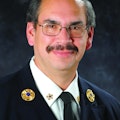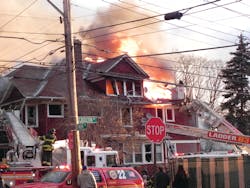Is it possible to make a dangerous job safer? Currently, much testing and debate are going on across the U.S. fire service. Underwriters Laboratories (UL) is conducting full-size, fully furnished tests of one- and two-family dwellings within its burn structure on the proper procedures and timing of vertical ventilation. This follows last year’s testing of horizontal ventilation procedures (see Safety & Survival on page 24). The FDNY has been holding meetings with senior members from all ranks regarding ventilation, airflow paths and timing of said ventilation.
To operate in the safest way possible, the results of these tests and discussions will change tactics and let commanders, fire officers and firefighters attack fires in the safest way possible, but in our business may not always be the case. District Chief Pete Van Dorpe and Firefighter James Dalton of the Chicago, IL, Fire Department will discuss the UL testing at Firehouse Expo 2012 in Baltimore, MD. Rochester, NY, Lieutenant Tom Rogan, who recently operated at a well-involved house fire, and West Haverstraw, NY, Firefighter Jerry Knapp, who was nearly killed in a gas explosion, will present programs and discuss their recent close calls. These incidents just don’t happen to the other guy. You never know what the next alarm may bring.
Recently, the editors from all the fire service magazines and fire service websites got together on a conference call. The meeting was called by Ron Siarnicki, executive director of the National Fallen Firefighters Foundation (NFFF), and Billy Goldfeder, a member of the NFFF Board of Directors and international director of the International Association of Fire Chiefs (IAFC) Safety, Health and Survival Section. There was troubling news to report – two fire service personnel from different parts of the country had just committed suicide. As I was writing this editorial, another firefighter did the same. The NFFF leadership wants to get the word that help is available for people who are suffering and going through tough times. Help is really a phone call away. All of the editors are addressing the subject and letting the fire service know help is available.
Here are several links and a book on the subject:
http://www.suicidology.org/media-professionals-reporting-suicide
http://www.psy.fsu.edu/faculty/joiner.dp.html
Joiner, T. (2005). Why people die by suicide. Cambridge, MA: Harvard University Press.
Two months ago, after I wrote in my an editorial about two New York City firefighters who died fighting a fire in the Deutsche Bank building, which was damaged in the 9/11 attack on the World Trade Center, a reader called to tell me a story. A firefighter who had studied for promotion in the Highbridge section of the Bronx always liked to go to fires. He sided and reroofed houses for everyone in the firehouse. Eventually, he was promoted and worked in Lower Manhattan. He was assigned to Ladder 5 in Greenwich Village. On Aug. 18, 2007, he was working “across the floor” in Engine 24. Numerous members were trapped on the upper floors of the building under demolition. The lieutenant barely made it out. Two of his firefighters that day were taken to the hospital. Apparently, the worst thing the lieutenant ever had to deal with was when these two firefighters were pronounced dead in the emergency room. He was hit hard. The fire took its toll on him. He was off for several months and told a friend, “I don’t know if I want to go to a fire again.” He retired on a disability. With the never-ending publicity surrounding the Trade Center, the officer finally took his life. Another tragedy behind the headlines whose cause maybe wasn’t so apparent.
For comments and suggestions, please contact us at [email protected].
TO BECOME AN ORGAN DONOR, SEE www.organdonor.gov & CHECK YOUR STATE’S REGULATIONS
11
2012 firefighter line-of-duty deaths at press time
326
2012 residential fire fatalities at press time
Follow us on
?
About the Author

Harvey Eisner
Editor Emeritus
HARVEY EISNER was named Editor Emeritus of Firehouse® after serving 15 years as Firehouse's Editor-in-Chief. He joined the Tenafly, NJ, Fire Department in 1975 and served as chief of department for 12 years. He was a firefighter in the Stillwater, OK, Fire Department for three years while attending Oklahoma State University. Eisner was an honorary assistant chief of the FDNY and program director for the Firehouse Expo, Firehouse World and Firehouse Central conferences. He covered many major fires and disasters and interviewed numerous fire service leaders for Firehouse®
